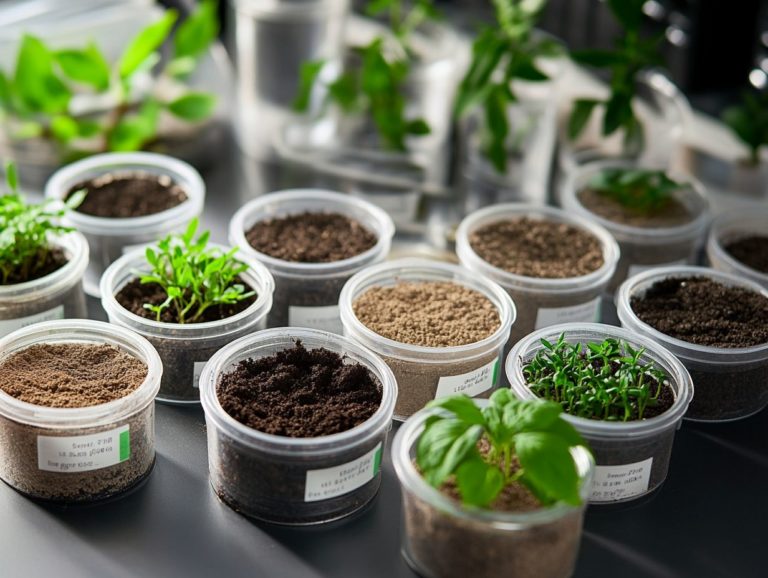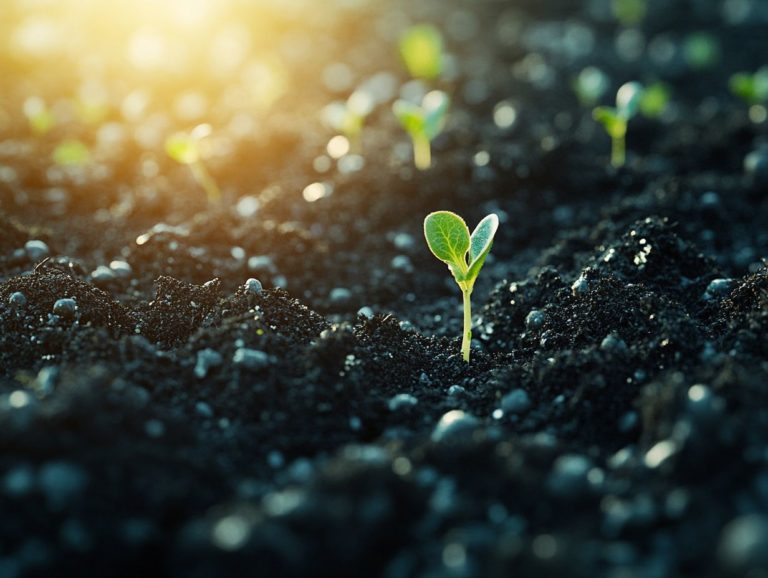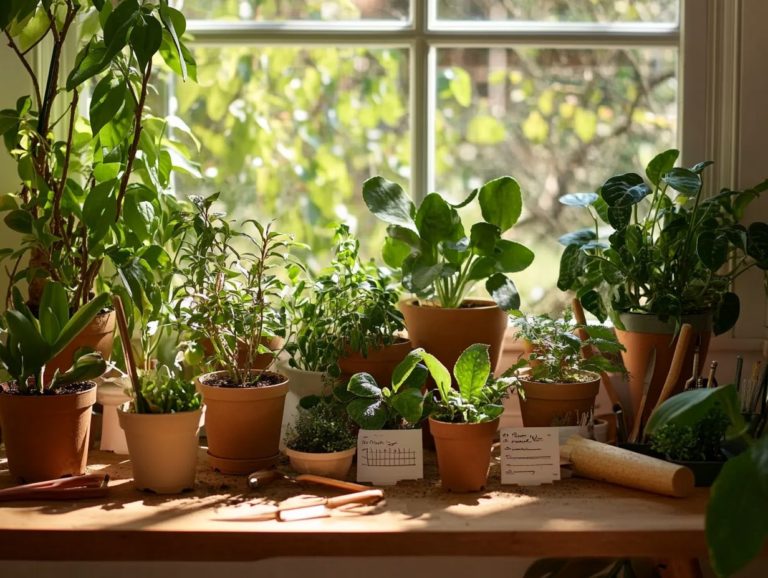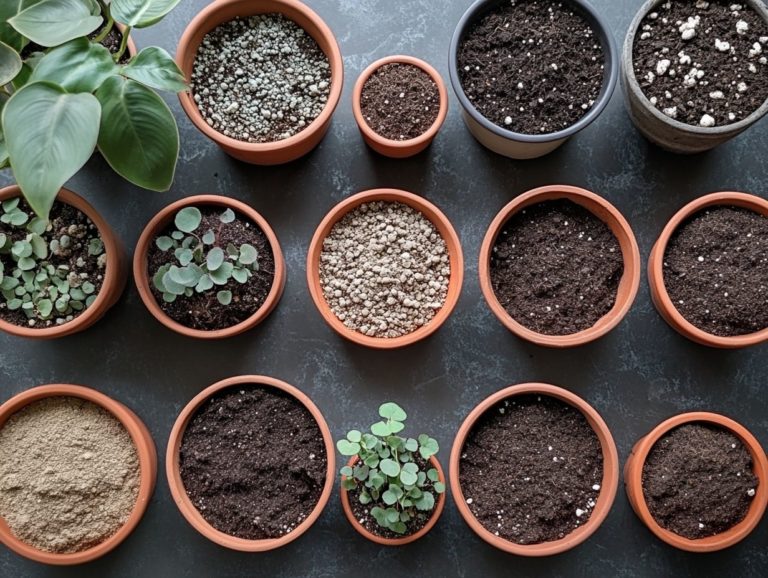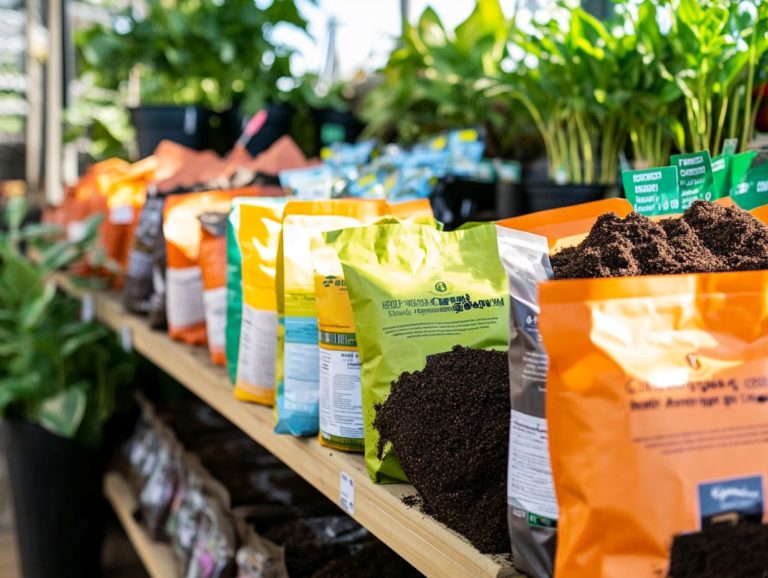The Best Time to Fertilize Indoor Plants
Indoor plants can bring life to any space. To keep them healthy, you need to understand their nutritional needs.
Understanding why fertilizer is important is key, as it has a direct impact on your plants’ growth and vitality.
This guide covers the key factors you should consider when fertilizing your indoor plants. You’ll learn how to select the right fertilizer based on the type of plant and its growth stage. You will also discover the optimal timing for applications to ensure maximum effectiveness.
You ll find insights on recognizing signs of nutrient deficiencies, exploring effective fertilization methods, and even some natural alternatives.
Whether you re an expert or just starting, this guide will help you keep your plants thriving and vibrant.
Contents
- Key Takeaways:
- Understanding Indoor Plant Nutrition
- Factors to Consider for Fertilizing Indoor Plants
- Environmental Conditions
- Timing of Fertilization
- General Recommendations
- Signs That Your Indoor Plants Need Fertilizer
- Identifying Nutrient Deficiencies
- How to Fertilize Indoor Plants
- Alternative Nutrient Sources for Indoor Plants
- Frequently Asked Questions
- When is the best time to fertilize my indoor plants?
- Can I fertilize my indoor plants during the winter?
- How often should I fertilize my indoor plants?
- What type of fertilizer is best for indoor plants?
- Is it possible to over-fertilize my indoor plants?
- Can I use natural alternatives to chemical fertilizers for my indoor plants?
Key Takeaways:

- Proper fertilization is crucial for the growth and health of indoor plants, as it provides essential nutrients for their development.
- The best time to fertilize indoor plants depends on their type, growth stage, and environmental conditions, with general recommendations suggesting fertilizing during the growing season.
- Signs of nutrient deficiencies, such as yellowing leaves or stunted growth, indicate that it may be time to fertilize your indoor plants. Consider using natural or DIY options as alternative nutrient sources.
Understanding Indoor Plant Nutrition
Grasping the intricacies of indoor plant nutrition is essential for nurturing vibrant, resilient houseplants. Proper care means recognizing the key nutrients required for growth, encompassing both big and small nutrients.
These nutrients, sourced from an array of fertilizers, are crucial for ensuring your plants flourish in their indoor setting, especially when it comes to optimizing soil quality and refining your watering techniques.
The Role of Fertilizer in Plant Growth
Fertilizer plays a vital role in nurturing your houseplants, supplying the essential nutrients they need to thrive in your indoor oasis.
You have a range of fertilizers to choose from liquid, granular, and organic options each tailored to meet specific growth needs and applications.
Liquid fertilizers are often your go-to for quick absorption, making them perfect for delivering nutrients rapidly during those critical growth phases. On the flip side, granular fertilizers offer a slow-release option, ensuring a steady supply of nutrients over time. If you’re leaning towards sustainability, organic fertilizers introduce beneficial microbes into the soil, promoting long-term health and resilience.
Whichever type you select, striving for a balanced nutrient profile is essential. This approach not only supports robust plant growth but also enhances their overall vitality, making them more resilient to pests and diseases.
Factors to Consider for Fertilizing Indoor Plants
When fertilizing your indoor plants, consider the type of plant, its growth stage, and your indoor environment.
Grasping these elements is essential for selecting the right fertilizers whether you opt for water-soluble or slow-release formulas ensuring they meet the unique needs of each houseplant in your care.
Plant Type and Growth Stage
The type of plant you have and its specific growth stage play a crucial role in determining the right fertilizer and how often you should apply it.
For example, succulents, which are often chosen for their low maintenance, thrive best on fertilizers rich in phosphorus during their juvenile stage. This promotes strong root development something every succulent needs to flourish.
On the other hand, tropical plants, celebrated for their lush foliage, typically require a balanced fertilizer ratio once they reach maturity.
Understanding the differing needs based on growth stages is essential. Juvenile plants tend to benefit from diluted solutions, while their mature counterparts may require more concentrated nutrient applications to sustain their larger biomass.
By customizing nutrient ratios to meet the specific demands of various houseplants, you can encourage healthy growth and robust development throughout their lifecycle.
Don’t wait! Start fertilizing your plants today for the best results!
Environmental Conditions
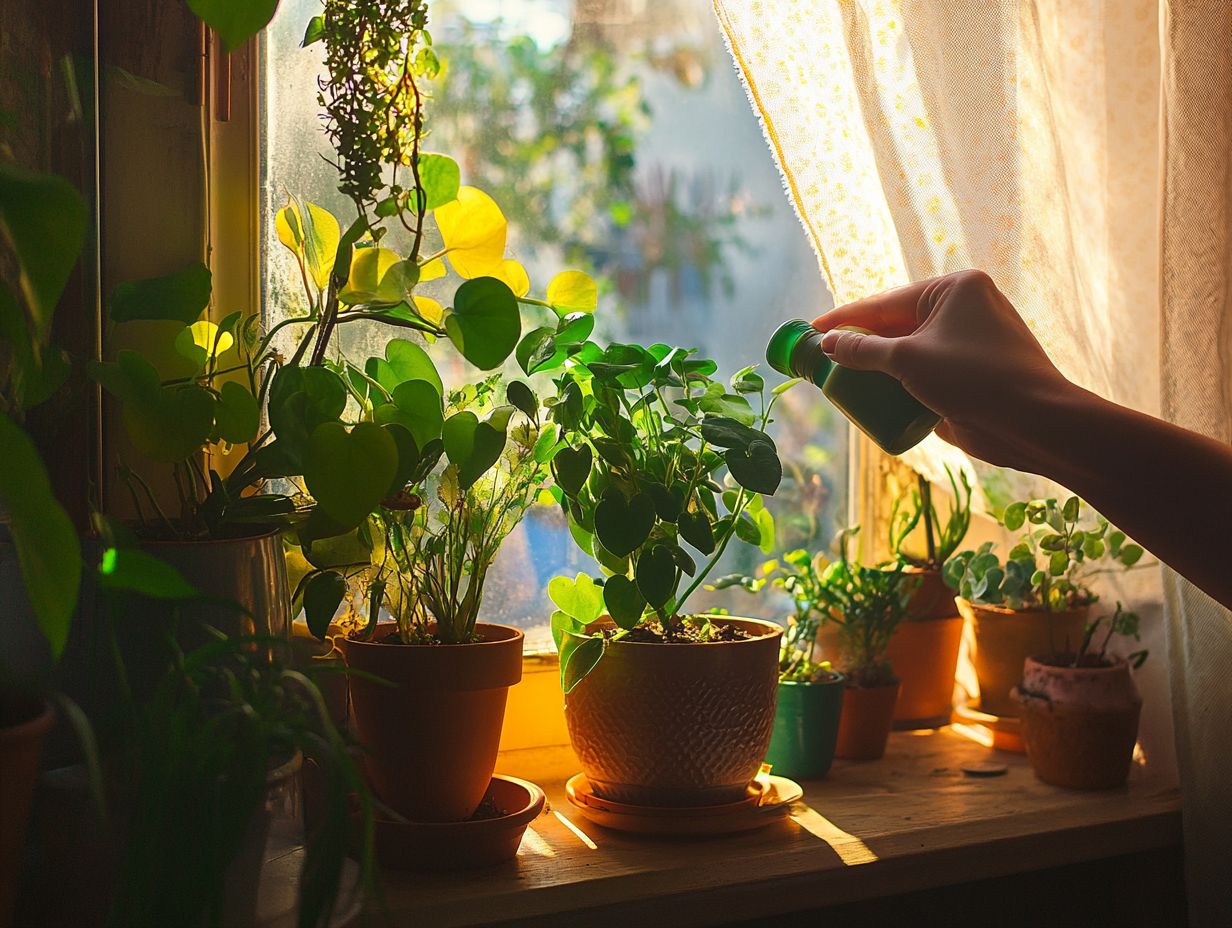
Environmental conditions, such as light and temperature, are essential for fertilizing your houseplants effectively.
When light intensity and duration are optimal, your plants can photosynthesize efficiently, absorbing nutrients better. Insufficient light leads to stunted growth, making it hard for your plants to benefit from fertilizers.
Temperature also significantly affects the metabolic rate of houseplants. Warmer environments enhance nutrient absorption, while cooler temperatures can slow biological processes. Understanding these indoor conditions is crucial for timing and applying fertilizer correctly, including using the top 10 fertilizers for thriving indoor plants.
Timing of Fertilization
The timing of fertilization is crucial for plant growth and health. Each houseplant has unique needs influenced by seasonal shifts and growth patterns.
Understand when to apply fertilizers to enhance nutrient availability and boost your plants’ vitality.
General Recommendations
For fertilizing your houseplants, a balanced approach is key for growth and nutrient absorption. Consider each plant’s unique requirements; some thrive on higher levels of nitrogen, phosphorus, or potassium.
A good starting point is a 10-10-10 all-purpose fertilizer. Apply it at half strength during the growing season, which runs from spring to early fall.
Keep a close eye on your plants health. Yellowing leaves may indicate nitrogen deficiency, while burnt leaf edges suggest over-fertilization. Fertilizing in the evening can help prevent nutrient burn.
Opting for a water-soluble fertilizer provides an immediate nutrient boost whenever your plants need it.
Signs That Your Indoor Plants Need Fertilizer
Pay attention to signs that your indoor plants need fertilizer to keep them healthy and vibrant. Nutrient deficiencies can slow growth and cause issues, so staying attuned to their needs is vital.
Identifying Nutrient Deficiencies
Look for signs of nutrient deficiencies, such as yellowing leaves or poor flowering. Each deficiency presents unique symptoms.
Nitrogen deficiency often makes older leaves yellow and drop. A phosphorus deficiency might stunt growth, showing dark green leaves with purplish hues.
Often, potassium deficiency appears as brown leaf edges and increased disease vulnerability. Applying the right fertilizer either a balanced NPK mix (Nitrogen, Phosphorus, and Potassium) or a specialized blend can restore nutrients and revitalize your plants.
How to Fertilize Indoor Plants
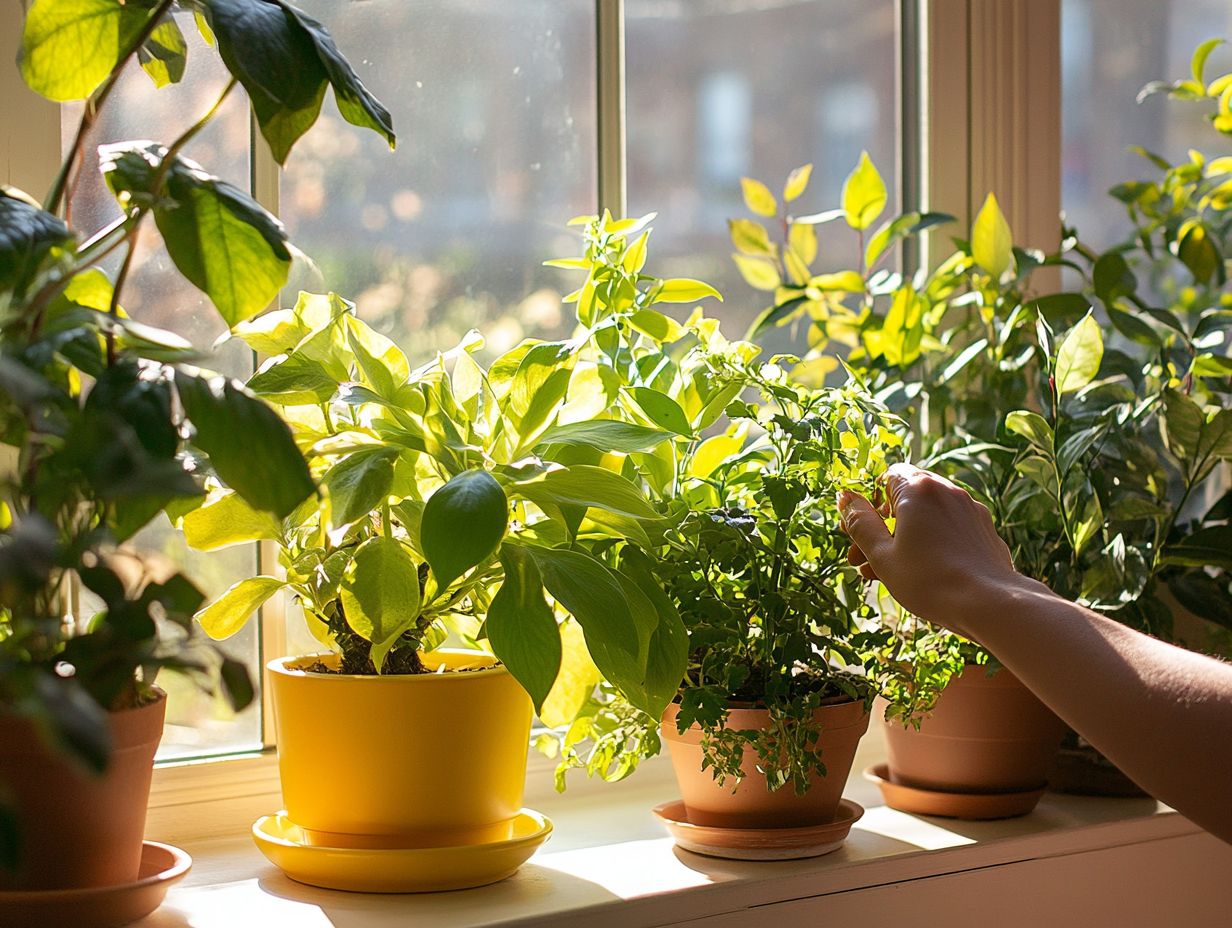
Fertilizing indoor plants involves several methods tailored to meet their unique needs. Understanding these approaches helps your plants absorb the essential nutrients for growth.
Methods and Techniques
There are several effective methods and techniques for fertilizing your indoor plants. You can use organic and water-soluble fertilizers. Each method has its own advantages and disadvantages that can significantly influence your plants’ health.
For instance, foliar feeding means feeding plants by spraying nutrients on their leaves. This method allows nutrients to be absorbed quickly, but you may need to apply it more often. Soil drenching offers a controlled release of nutrients directly to the roots, which many find enhances plant stability.
Then there are slow-release fertilizers. They provide convenience by reducing the need for constant monitoring; however, they might not deliver nutrients at critical moments when your plants crave them.
Understand these tips to choose the best fertilizer and help your plants thrive!
Alternative Nutrient Sources for Indoor Plants
Explore alternative nutrient sources to find sustainable and eco-friendly options. These options not only support healthy growth but also align with your commitment to natural gardening methods.
This approach allows you to nurture your plants while being mindful of the environment. Make your gardening experience both rewarding and responsible.
Natural and DIY Options
Natural and DIY options for fertilizing your indoor plants are rewarding. Consider using homemade compost or fish emulsion to enrich your soil.
These alternatives not only supply essential nutrients but also contribute to a healthier, more vibrant indoor garden. You can repurpose kitchen scraps like vegetable peels or coffee grounds, which can be composted into nutrient-rich feed for your plants.
Another excellent approach is to dilute fish emulsion in water. This provides vital nitrogen that encourages lush foliage growth.
By choosing these eco-friendly options, you can cultivate a thriving environment while minimizing chemical exposure. This ultimately fosters stronger root systems and enhances the overall health of your plants.
Frequently Asked Questions
When is the best time to fertilize my indoor plants?
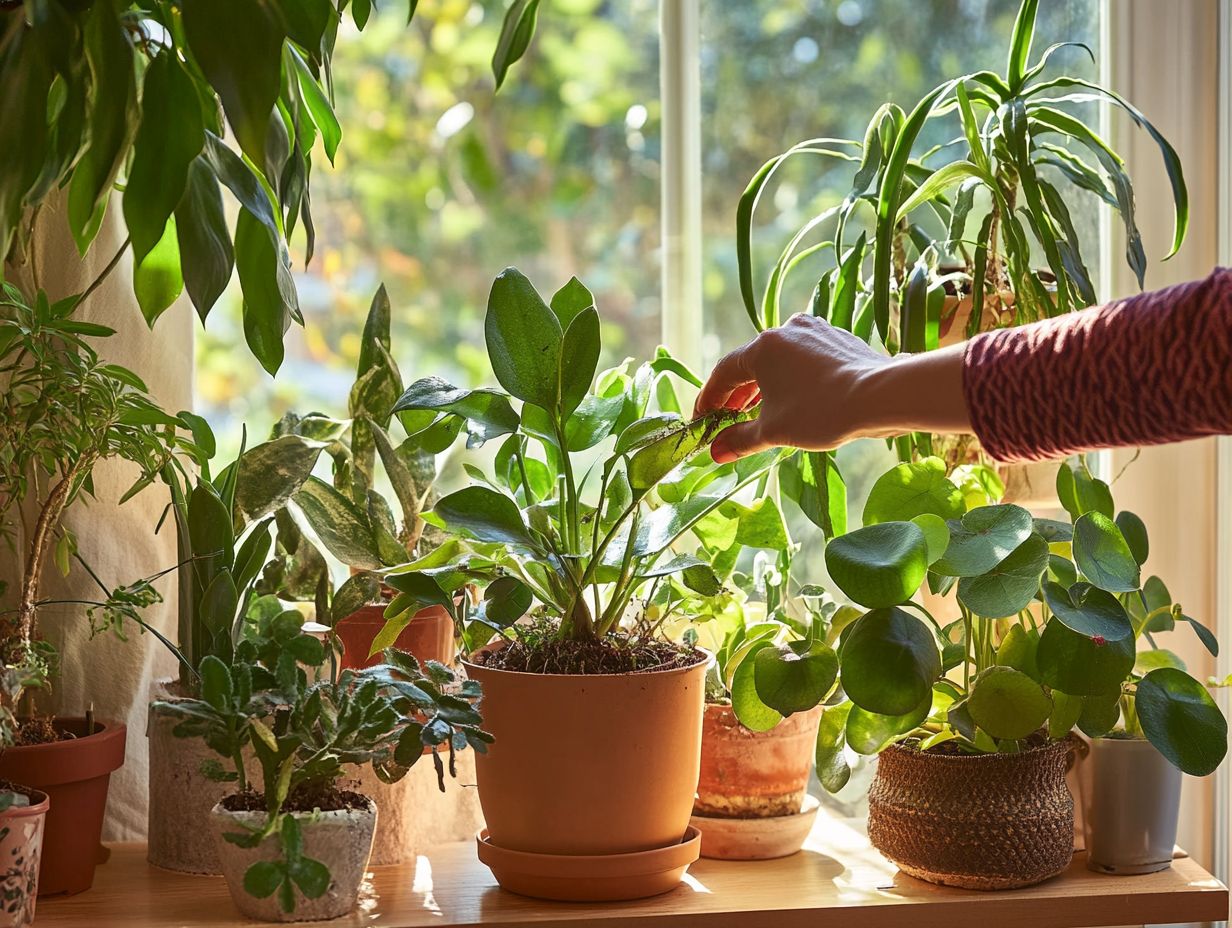
The best time to fertilize indoor plants is during their active growing season, typically in spring and summer. This is when they need more nutrients to support their growth.
Can I fertilize my indoor plants during the winter?
It is not necessary to fertilize your indoor plants during the winter months. Most plants are dormant and do not require extra nutrients. Wait until spring when they resume their growth.
How often should I fertilize my indoor plants?
The frequency of fertilizing your indoor plants depends on the plant’s needs and the type of fertilizer. In general, most plants can be fertilized every 2-4 weeks during the active growing season.
What type of fertilizer is best for indoor plants?
The best type of fertilizer for indoor plants is a balanced, water-soluble fertilizer. Look for one with equal parts nitrogen, phosphorus, and potassium (NPK) to ensure your plants get all the necessary nutrients.
Is it possible to over-fertilize my indoor plants?
Yes, over-fertilizing can damage roots and leaves. Always follow the instructions on the fertilizer package and do not exceed the recommended amount.
Can I use natural alternatives to chemical fertilizers for my indoor plants?
Yes, there are natural alternatives to chemical fertilizers for indoor plants. Options like compost, fish emulsion, and seaweed extract provide nutrients in a more organic and gentle way.
Start using these techniques today and watch your indoor garden transform into a flourishing paradise!

